Zekai Chen
SADA: Stability-guided Adaptive Diffusion Acceleration
Jul 23, 2025Abstract:Diffusion models have achieved remarkable success in generative tasks but suffer from high computational costs due to their iterative sampling process and quadratic attention costs. Existing training-free acceleration strategies that reduce per-step computation cost, while effectively reducing sampling time, demonstrate low faithfulness compared to the original baseline. We hypothesize that this fidelity gap arises because (a) different prompts correspond to varying denoising trajectory, and (b) such methods do not consider the underlying ODE formulation and its numerical solution. In this paper, we propose Stability-guided Adaptive Diffusion Acceleration (SADA), a novel paradigm that unifies step-wise and token-wise sparsity decisions via a single stability criterion to accelerate sampling of ODE-based generative models (Diffusion and Flow-matching). For (a), SADA adaptively allocates sparsity based on the sampling trajectory. For (b), SADA introduces principled approximation schemes that leverage the precise gradient information from the numerical ODE solver. Comprehensive evaluations on SD-2, SDXL, and Flux using both EDM and DPM++ solvers reveal consistent $\ge 1.8\times$ speedups with minimal fidelity degradation (LPIPS $\leq 0.10$ and FID $\leq 4.5$) compared to unmodified baselines, significantly outperforming prior methods. Moreover, SADA adapts seamlessly to other pipelines and modalities: It accelerates ControlNet without any modifications and speeds up MusicLDM by $1.8\times$ with $\sim 0.01$ spectrogram LPIPS.
A Comprehensive Data-centric Overview of Federated Graph Learning
Jul 22, 2025Abstract:In the era of big data applications, Federated Graph Learning (FGL) has emerged as a prominent solution that reconcile the tradeoff between optimizing the collective intelligence between decentralized datasets holders and preserving sensitive information to maximum. Existing FGL surveys have contributed meaningfully but largely focus on integrating Federated Learning (FL) and Graph Machine Learning (GML), resulting in early stage taxonomies that emphasis on methodology and simulated scenarios. Notably, a data centric perspective, which systematically examines FGL methods through the lens of data properties and usage, remains unadapted to reorganize FGL research, yet it is critical to assess how FGL studies manage to tackle data centric constraints to enhance model performances. This survey propose a two-level data centric taxonomy: Data Characteristics, which categorizes studies based on the structural and distributional properties of datasets used in FGL, and Data Utilization, which analyzes the training procedures and techniques employed to overcome key data centric challenges. Each taxonomy level is defined by three orthogonal criteria, each representing a distinct data centric configuration. Beyond taxonomy, this survey examines FGL integration with Pretrained Large Models, showcases realistic applications, and highlights future direction aligned with emerging trends in GML.
FedC4: Graph Condensation Meets Client-Client Collaboration for Efficient and Private Federated Graph Learning
Apr 19, 2025Abstract:Federated Graph Learning (FGL) is an emerging distributed learning paradigm that enables collaborative model training over decentralized graph-structured data while preserving local privacy. Existing FGL methods can be categorized into two optimization architectures: (1) the Server-Client (S-C) paradigm, where clients upload local models for server-side aggregation; and (2) the Client-Client (C-C) paradigm, which allows direct information exchange among clients to support personalized training. Compared to S-C, the C-C architecture better captures global graph knowledge and enables fine-grained optimization through customized peer-to-peer communication. However, current C-C methods often broadcast identical and redundant node embeddings, incurring high communication costs and privacy risks. To address this, we propose FedC4, a novel framework that combines graph Condensation with Client-Client Collaboration. Instead of transmitting raw node-level features, FedC4 distills each client's private graph into a compact set of synthetic node embeddings, reducing communication overhead and enhancing privacy. In addition, FedC4 introduces three modules that allow source clients to send distinct node representations tailored to target clients'graph structures, enabling personalized optimization with global guidance. Extensive experiments on eight real-world datasets show that FedC4 outperforms state-of-the-art baselines in both performance and communication efficiency.
Advancing High Resolution Vision-Language Models in Biomedicine
Jun 12, 2024Abstract:Multi-modal learning has significantly advanced generative AI, especially in vision-language modeling. Innovations like GPT-4V and open-source projects such as LLaVA have enabled robust conversational agents capable of zero-shot task completions. However, applying these technologies in the biomedical field presents unique challenges. Recent initiatives like LLaVA-Med have started to adapt instruction-tuning for biomedical contexts using large datasets such as PMC-15M. Our research offers three key contributions: (i) we present a new instruct dataset enriched with medical image-text pairs from Claude3-Opus and LLaMA3 70B, (ii) we propose a novel image encoding strategy using hierarchical representations to improve fine-grained biomedical visual comprehension, and (iii) we develop the Llama3-Med model, which achieves state-of-the-art zero-shot performance on biomedical visual question answering benchmarks, with an average performance improvement of over 10% compared to previous methods. These advancements provide more accurate and reliable tools for medical professionals, bridging gaps in current multi-modal conversational assistants and promoting further innovations in medical AI.
Online Personalizing White-box LLMs Generation with Neural Bandits
Apr 24, 2024



Abstract:The advent of personalized content generation by LLMs presents a novel challenge: how to efficiently adapt text to meet individual preferences without the unsustainable demand of creating a unique model for each user. This study introduces an innovative online method that employs neural bandit algorithms to dynamically optimize soft instruction embeddings based on user feedback, enhancing the personalization of open-ended text generation by white-box LLMs. Through rigorous experimentation on various tasks, we demonstrate significant performance improvements over baseline strategies. NeuralTS, in particular, leads to substantial enhancements in personalized news headline generation, achieving up to a 62.9% improvement in terms of best ROUGE scores and up to 2.76% increase in LLM-agent evaluation against the baseline.
AdaptiveFL: Adaptive Heterogeneous Federated Learning for Resource-Constrained AIoT Systems
Nov 22, 2023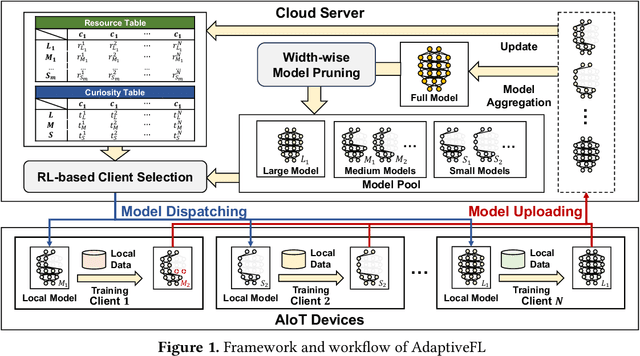
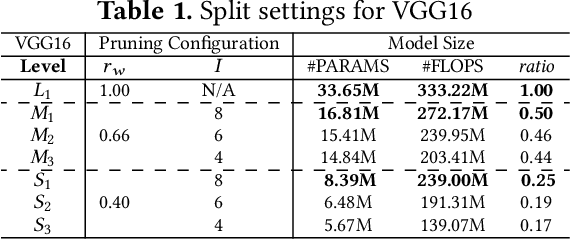
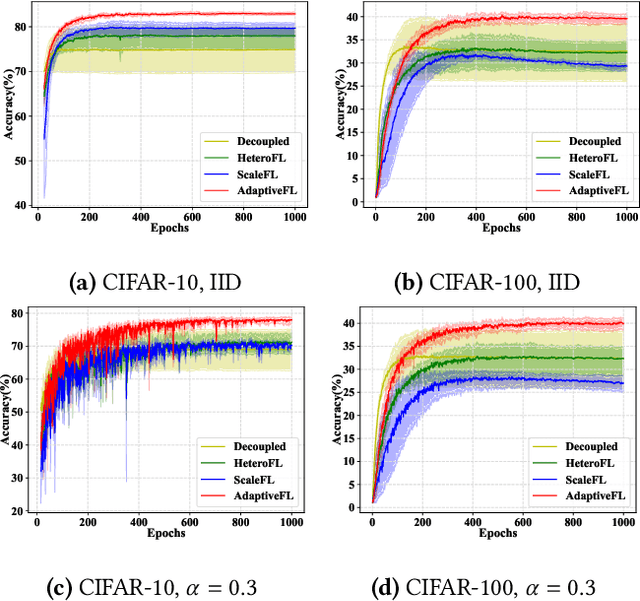

Abstract:Although Federated Learning (FL) is promising to enable collaborative learning among Artificial Intelligence of Things (AIoT) devices, it suffers from the problem of low classification performance due to various heterogeneity factors (e.g., computing capacity, memory size) of devices and uncertain operating environments. To address these issues, this paper introduces an effective FL approach named AdaptiveFL based on a novel fine-grained width-wise model pruning strategy, which can generate various heterogeneous local models for heterogeneous AIoT devices. By using our proposed reinforcement learning-based device selection mechanism, AdaptiveFL can adaptively dispatch suitable heterogeneous models to corresponding AIoT devices on the fly based on their available resources for local training. Experimental results show that, compared to state-of-the-art methods, AdaptiveFL can achieve up to 16.83% inference improvements for both IID and non-IID scenarios.
Fedward: Flexible Federated Backdoor Defense Framework with Non-IID Data
Jul 01, 2023Abstract:Federated learning (FL) enables multiple clients to collaboratively train deep learning models while considering sensitive local datasets' privacy. However, adversaries can manipulate datasets and upload models by injecting triggers for federated backdoor attacks (FBA). Existing defense strategies against FBA consider specific and limited attacker models, and a sufficient amount of noise to be injected only mitigates rather than eliminates FBA. To address these deficiencies, we introduce a Flexible Federated Backdoor Defense Framework (Fedward) to ensure the elimination of adversarial backdoors. We decompose FBA into various attacks, and design amplified magnitude sparsification (AmGrad) and adaptive OPTICS clustering (AutoOPTICS) to address each attack. Meanwhile, Fedward uses the adaptive clipping method by regarding the number of samples in the benign group as constraints on the boundary. This ensures that Fedward can maintain the performance for the Non-IID scenario. We conduct experimental evaluations over three benchmark datasets and thoroughly compare them to state-of-the-art studies. The results demonstrate the promising defense performance from Fedward, moderately improved by 33% $\sim$ 75 in clustering defense methods, and 96.98%, 90.74%, and 89.8% for Non-IID to the utmost extent for the average FBA success rate over MNIST, FMNIST, and CIFAR10, respectively.
Masked Image Modeling Advances 3D Medical Image Analysis
Apr 25, 2022
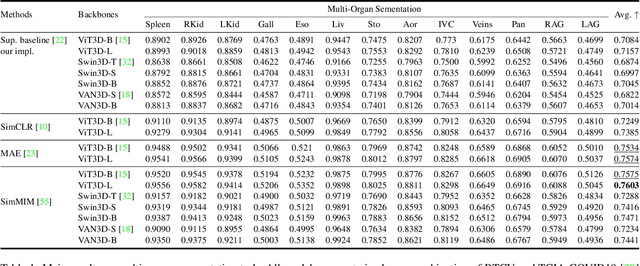
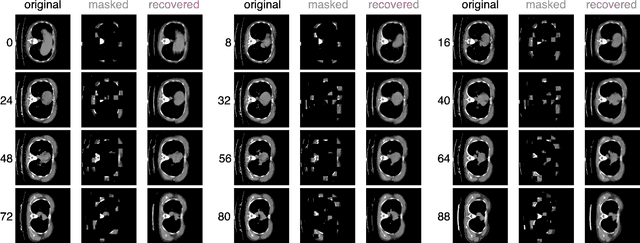
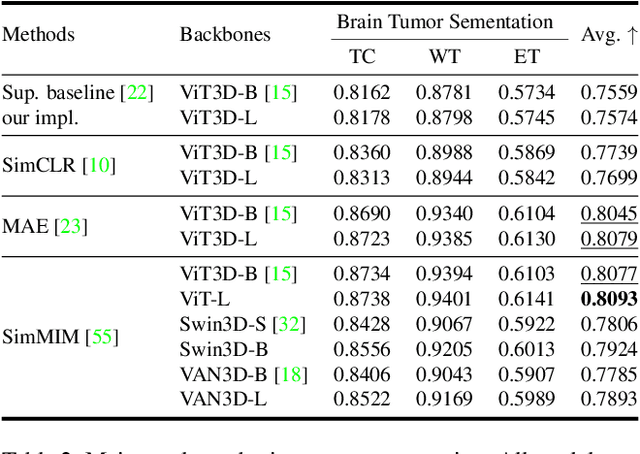
Abstract:Recently, masked image modeling (MIM) has gained considerable attention due to its capacity to learn from vast amounts of unlabeled data and has been demonstrated to be effective on a wide variety of vision tasks involving natural images. Meanwhile, the potential of self-supervised learning in modeling 3D medical images is anticipated to be immense due to the high quantities of unlabeled images, and the expense and difficulty of quality labels. However, MIM's applicability to medical images remains uncertain. In this paper, we demonstrate that masked image modeling approaches can also advance 3D medical images analysis in addition to natural images. We study how masked image modeling strategies leverage performance from the viewpoints of 3D medical image segmentation as a representative downstream task: i) when compared to naive contrastive learning, masked image modeling approaches accelerate the convergence of supervised training even faster (1.40$\times$) and ultimately produce a higher dice score; ii) predicting raw voxel values with a high masking ratio and a relatively smaller patch size is non-trivial self-supervised pretext-task for medical images modeling; iii) a lightweight decoder or projection head design for reconstruction is powerful for masked image modeling on 3D medical images which speeds up training and reduce cost; iv) finally, we also investigate the effectiveness of MIM methods under different practical scenarios where different image resolutions and labeled data ratios are applied.
DCAP: Deep Cross Attentional Product Network for User Response Prediction
May 18, 2021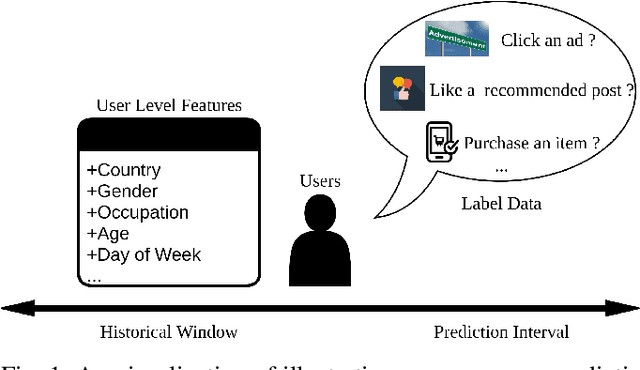
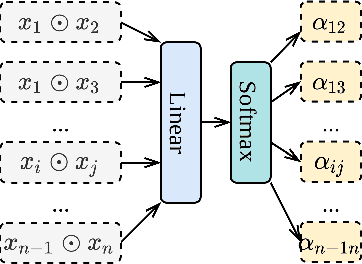
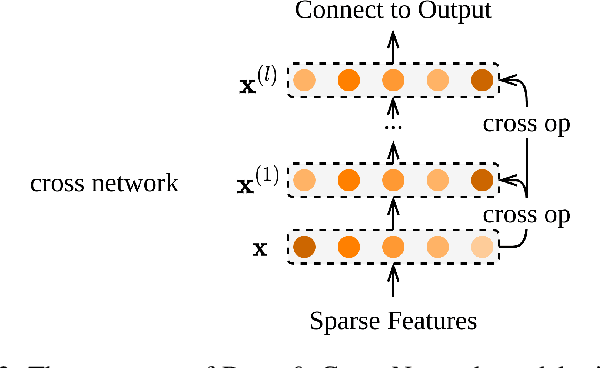

Abstract:User response prediction, which aims to predict the probability that a user will provide a predefined positive response in a given context such as clicking on an ad or purchasing an item, is crucial to many industrial applications such as online advertising, recommender systems, and search ranking. However, due to the high dimensionality and super sparsity of the data collected in these tasks, handcrafting cross features is inevitably time expensive. Prior studies in predicting user response leveraged the feature interactions by enhancing feature vectors with products of features to model second-order or high-order cross features, either explicitly or implicitly. Nevertheless, these existing methods can be hindered by not learning sufficient cross features due to model architecture limitations or modeling all high-order feature interactions with equal weights. This work aims to fill this gap by proposing a novel architecture Deep Cross Attentional Product Network (DCAP), which keeps cross network's benefits in modeling high-order feature interactions explicitly at the vector-wise level. Beyond that, it can differentiate the importance of different cross features in each network layer inspired by the multi-head attention mechanism and Product Neural Network (PNN), allowing practitioners to perform a more in-depth analysis of user behaviors. Additionally, our proposed model can be easily implemented and train in parallel. We conduct comprehensive experiments on three real-world datasets. The results have robustly demonstrated that our proposed model DCAP achieves superior prediction performance compared with the state-of-the-art models.
ASM2TV: An Adaptive Semi-Supervised Multi-Task Multi-View Learning Framework
May 18, 2021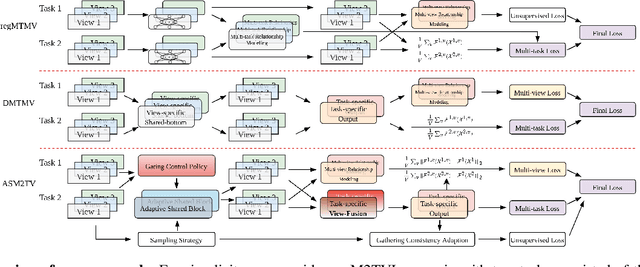
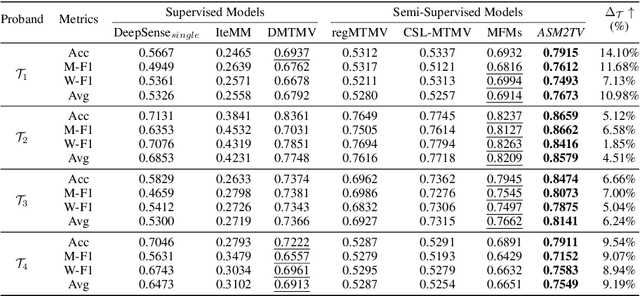
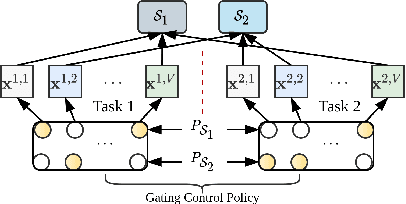
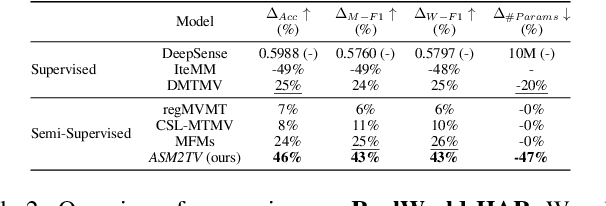
Abstract:Many real-world scenarios, such as human activity recognition (HAR) in IoT, can be formalized as a multi-task multi-view learning problem. Each specific task consists of multiple shared feature views collected from multiple sources, either homogeneous or heterogeneous. Common among recent approaches is to employ a typical hard/soft sharing strategy at the initial phase separately for each view across tasks to uncover common knowledge, underlying the assumption that all views are conditionally independent. On the one hand, multiple views across tasks possibly relate to each other under practical situations. On the other hand, supervised methods might be insufficient when labeled data is scarce. To tackle these challenges, we introduce a novel framework ASM2TV for semi-supervised multi-task multi-view learning. We present a new perspective named gating control policy, a learnable task-view-interacted sharing policy that adaptively selects the most desirable candidate shared block for any view across any task, which uncovers more fine-grained task-view-interacted relatedness and improves inference efficiency. Significantly, our proposed gathering consistency adaption procedure takes full advantage of large amounts of unlabeled fragmented time-series, making it a general framework that accommodates a wide range of applications. Experiments on two diverse real-world HAR benchmark datasets collected from various subjects and sources demonstrate our framework's superiority over other state-of-the-arts.
 Add to Chrome
Add to Chrome Add to Firefox
Add to Firefox Add to Edge
Add to Edge